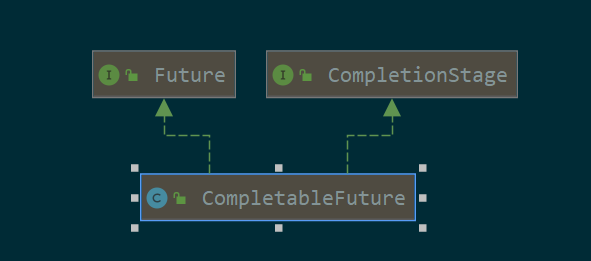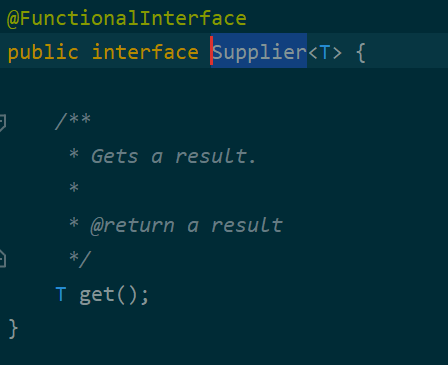Java源码分析系列笔记-15.CompletableFuture
1. 是什么
用于异步编程。(准备说是非阻塞)
Java中所谓的异步编程其实就是把阻塞的代码放在一个单独的线程中执行,并且有结果时会通知主线程
2. Future VS CompletableFutre
| Future | CompletableFutre | |
|---|---|---|
| 结果获取方式 | 主动轮询。使用isDone来检查调用是否完成,get用来获取执行的结果 | 异步回调。使用回调函数 |
| 异常处理 | 不支持 | 支持 |
| 链式调用 | 不支持 | 支持 |
| 可以手动完成一个任务 | 不支持 | 支持 |
3. 使用
3.1. 运行一个不返回结果的任务
CompletableFuture<Void> future = CompletableFuture.runAsync(() -> {
try
{
TimeUnit.SECONDS.sleep(5);
}
catch (InterruptedException e)
{
throw new IllegalStateException(e);
}
System.out.println("后台任务完成");
});
future.get();
3.2. 运行一个返回结果的任务
CompletableFuture<String> future = CompletableFuture.supplyAsync(() -> {
try
{
TimeUnit.SECONDS.sleep(5);
}
catch (InterruptedException e)
{
throw new IllegalStateException(e);
}
return "后台任务完成";
});
String s = future.get();
System.out.println(s);
3.3. 线程池
默认使用ForkJoin的commonpool里的线程池执行任务,但是也可以使用Executor作为第二个参数指定运行的线程池
Executor executor = Executors.newFixedThreadPool(10);
CompletableFuture<String> future = CompletableFuture.supplyAsync(() -> {
try {
TimeUnit.SECONDS.sleep(1);
} catch (InterruptedException e) {
throw new IllegalStateException(e);
}
return "Result of the asynchronous computation";
}, executor);
3.4. 手动完成任务
CompletableFuture<String> stringCompletableFuture = new CompletableFuture<>();
new Thread(()->{
try
{
TimeUnit.SECONDS.sleep(5);
}
catch (InterruptedException e)
{
e.printStackTrace();
}
stringCompletableFuture.complete("手动完成任务");
}).run();
String s = stringCompletableFuture.get();
System.out.println(s);
3.5. 回调
- thenApply() 接受结果作为参数,有返回
- thenAccept() 接受结果作为参数,无返回
- thenRun() 无参数,无返回
System.out.println("start");
CompletableFuture<String> future = CompletableFuture.supplyAsync(() -> {
try
{
TimeUnit.SECONDS.sleep(5);
}
catch (InterruptedException e)
{
throw new IllegalStateException(e);
}
return "后台任务完成";
});
future.thenAccept(System.out::println);
System.out.println("主线程继续执行并且休眠10s");
TimeUnit.SECONDS.sleep(10);
3.6. 链式调用
System.out.println("start");
CompletableFuture<String> future = CompletableFuture.supplyAsync(() -> {
try
{
TimeUnit.SECONDS.sleep(5);
}
catch (InterruptedException e)
{
throw new IllegalStateException(e);
}
return "后台任务完成";
});
future.thenApply(s->{
System.out.println(Thread.currentThread().getName() + "s");
return s;
}).thenApply(s->{
System.out.println(Thread.currentThread().getName() + "s");
return s;
});
System.out.println("主线程继续执行并且休眠10s");
TimeUnit.SECONDS.sleep(10);
3.7. 组合多个CompletableFuture
- thenCompose() 有依赖的两个Future
- thenCombine() 没有依赖的两个Future
- CompletableFuture.allOf 所有Future完成
- CompletableFuture.anyOf 任意一个Future完成
System.out.println("start runnning............");
long start = System.currentTimeMillis();
CompletableFuture<String> future1
= CompletableFuture.supplyAsync(() ->
{
try
{
TimeUnit.SECONDS.sleep(5);
}
catch (InterruptedException e)
{
e.printStackTrace();
}
System.out.println("Hello" + Thread.currentThread().getName());
return "Hello";
}
);
CompletableFuture<String> future2
= CompletableFuture.supplyAsync(() ->
{
try
{
TimeUnit.SECONDS.sleep(8);
}
catch (InterruptedException e)
{
e.printStackTrace();
}
System.out.println("Beautiful" + Thread.currentThread().getName());
return "Beautiful";
}
);
CompletableFuture<String> future3
= CompletableFuture.supplyAsync(() ->
{
try
{
TimeUnit.SECONDS.sleep(10);
}
catch (InterruptedException e)
{
e.printStackTrace();
}
System.out.println("World" + Thread.currentThread().getName());
return "World";
}
);
CompletableFuture<Void> combinedFuture
= CompletableFuture.allOf(future1, future2, future3);
combinedFuture.get();
long end = System.currentTimeMillis();
System.out.println("finish run...time is " + (end-start));
assertTrue(future1.isDone());
assertTrue(future2.isDone());
assertTrue(future3.isDone());
System.out.println(future1.get());
System.out.println(future2.get());
System.out.println(future3.get());
3.8. 异常处理
- exceptionally发生异常的时候调用
- handle无论发生异常与否都调用
CompletableFuture<Object> future = CompletableFuture.supplyAsync(() -> {
throw new IllegalArgumentException("Age can not be negative");
}).exceptionally(ex -> {
System.out.println("Oops! We have an exception - " + ex.getMessage());
return "Unknown!";
});
System.out.println(future.get());
4. 源码分析
4.1. 类图

可以看出CompletableFuture实现了Future接口,因此这玩意也是一个可以获取异步执行结果的接口
4.2. 属性
volatile Object result; // Either the result or boxed AltResult
volatile Completion stack; // Top of Treiber stack of dependent actions
运行的结果存在Object result,如果发生了异常那么封装在AltResult
4.2.1. AltResult
static final class AltResult { // See above
final Throwable ex; // null only for NIL
AltResult(Throwable x) { this.ex = x; }
}
/** The encoding of the null value. */
static final AltResult NIL = new AltResult(null);
4.3. runAsync
public static CompletableFuture<Void> runAsync(Runnable runnable) {
return asyncRunStage(asyncPool, runnable);
}
传入asyncPool和runnable任务调用asyncRunStage方法
我们先看看asyncPool是怎么初始化的
4.3.1. 初始化默认的线程池
//返回true
private static final boolean useCommonPool =
(ForkJoinPool.getCommonPoolParallelism() > 1);
//这里使用的是ForkJoinPool.commonPool()
private static final Executor asyncPool = useCommonPool ?
ForkJoinPool.commonPool() : new ThreadPerTaskExecutor();
所以默认使用的是ForkJoinPool.commonPool()
有了默认的线程池,接下来调用的asyncRunStage方法
- asyncRunStage
static CompletableFuture<Void> asyncRunStage(Executor e, Runnable f) {
if (f == null) throw new NullPointerException();
CompletableFuture<Void> d = new CompletableFuture<Void>();
e.execute(new AsyncRun(d, f));
return d;
}
- 2行:任务为空那么抛出异常
- 3行:构造CompletableFuture,用于接收结果
- 4行:先用CompletableFuture和Runnable构造AsyncRun,接口调用线程池Executor的execute方法执行这个AsyncRun
- 5行:返回CompletableFuture
4.3.2. 把执行的任务【Runnable】和接收结果【CompletableFuture】封装到AsyncRun
先看看AsyncRun类
- AsyncRun
static final class AsyncRun extends ForkJoinTask<Void>
implements Runnable, AsynchronousCompletionTask {
CompletableFuture<Void> dep; Runnable fn;
AsyncRun(CompletableFuture<Void> dep, Runnable fn) {
this.dep = dep; this.fn = fn;
}
public final Void getRawResult() { return null; }
public final void setRawResult(Void v) {}
public final boolean exec() { run(); return true; }
public void run() {
CompletableFuture<Void> d; Runnable f;
if ((d = dep) != null && (f = fn) != null) {
//清空CompletableFuture和Runnable
dep = null; fn = null;
//如果CompletableFuture的结果为空
if (d.result == null) {
try {
//那么执行Runnable方法
f.run();
//CAS设置CompletableFuture的结果为AltResult NIL--详见上面的AltResult
d.completeNull();
} catch (Throwable ex) {
//抛出了异常则CAS设置CompletableFuture的结果为AltResult(异常)--详见上面的AltResult
d.completeThrowable(ex);
}
}
d.postComplete();
}
}
}
- 2行:实现了Runnable接口
- 4-6行:构造方法只是保存了传进来的Runnable和CompletableFuture
- 12-26行:线程池的execute方法最终会调用这个run方法。详细说明见注释。
我们可以看看设置null结果和异常结果的方法
- completeNull【null】
final boolean completeNull() {
//CAS设置RESULT为NIL
return UNSAFE.compareAndSwapObject(this, RESULT, null,
NIL);
}
- completeThrowable【异常】
static AltResult encodeThrowable(Throwable x) {
return new AltResult((x instanceof CompletionException) ? x :
new CompletionException(x));
}
/** Completes with an exceptional result, unless already completed. */
final boolean completeThrowable(Throwable x) {
//CAS设置RESULT为AltResult(异常)
return UNSAFE.compareAndSwapObject(this, RESULT, null,
encodeThrowable(x));
}
4.3.3. 调用线程池的execute方法执行上面的AsyncRun
执行AsyncRun的时候最终会调用AsyncRun的run方法,分析如上面的把执行的任务【Runnable】和接收结果【CompletableFuture】封装到AsyncRun
4.4. supplyAsync
public static <U> CompletableFuture<U> supplyAsync(Supplier<U> supplier) {
return asyncSupplyStage(asyncPool, supplier);
}
传入默认的线程池asyncPool和任务supplier,这个supplier是Supplier【函数式接口】,如下图:

4.4.1. 初始化默认的线程池
初始化默认的线程池跟上面的runAsync一样
我们接着跟踪asyncSupplyStage方法
- asyncSupplyStage
static <U> CompletableFuture<U> asyncSupplyStage(Executor e,
Supplier<U> f) {
if (f == null) throw new NullPointerException();
CompletableFuture<U> d = new CompletableFuture<U>();
e.execute(new AsyncSupply<U>(d, f));
return d;
}
- 2行:任务为空那么抛出异常
- 3行:构造CompletableFuture,用于接收结果
- 4行:先用CompletableFuture和Supplier构造AsyncSupply,接口调用线程池Executor的execute方法执行这个AsyncSupply
- 5行:返回CompletableFuture
4.4.2. 把执行的任务【Supplier】和接收结果【CompletableFuture】封装到AsyncSupply
- AsyncSupply
static final class AsyncSupply<T> extends ForkJoinTask<Void>
implements Runnable, AsynchronousCompletionTask {
CompletableFuture<T> dep; Supplier<T> fn;
AsyncSupply(CompletableFuture<T> dep, Supplier<T> fn) {
this.dep = dep; this.fn = fn;
}
public final Void getRawResult() { return null; }
public final void setRawResult(Void v) {}
public final boolean exec() { run(); return true; }
public void run() {
CompletableFuture<T> d; Supplier<T> f;
if ((d = dep) != null && (f = fn) != null) {
//清空CompletableFuture和Runnable
dep = null; fn = null;
//如果CompletableFuture的结果为空
if (d.result == null) {
try {
//调用Supplier.get获取结果
//然后调用CompletableFuture.completeValue把结果设置进
d.completeValue(f.get());
} catch (Throwable ex) {
//抛出了异常则CAS设置CompletableFuture的结果为AltResult(异常)--详见上面的AltResult
d.completeThrowable(ex);
}
}
d.postComplete();
}
}
}
- 2行:实现了Runnable接口
- 4-6行:构造方法只是保存了传进来的Runnable和CompletableFuture
- 12-26行:线程池的execute方法最终会调用这个run方法。详细说明见注释。
我们可以看看设置结果的completeValue方法
- completeValue
final boolean completeValue(T t) {
return UNSAFE.compareAndSwapObject(this, RESULT, null,
(t == null) ? NIL : t);
}
4.4.3. 调用线程池的execute方法执行上面的AsyncRun
执行AsyncRun的时候最终会调用AsyncRun的run方法,分析如上面的把执行的任务【Supplier】和接收结果【CompletableFuture】封装到AsyncSupply
4.5. complete
public boolean complete(T value) {
boolean triggered = completeValue(value);
postComplete();
return triggered;
}
- 2行:手动设置结果
- 3行:执行钩子方法
4.5.1. 手动设置结果
final boolean completeValue(T t) {
return UNSAFE.compareAndSwapObject(this, RESULT, null,
(t == null) ? NIL : t);
}
4.5.2. 执行钩子方法
这段代码确定没看懂要干啥
final void postComplete() {
/*
* On each step, variable f holds current dependents to pop
* and run. It is extended along only one path at a time,
* pushing others to avoid unbounded recursion.
*/
CompletableFuture<?> f = this; Completion h;
while ((h = f.stack) != null ||
(f != this && (h = (f = this).stack) != null)) {
CompletableFuture<?> d; Completion t;
if (f.casStack(h, t = h.next)) {
if (t != null) {
if (f != this) {
pushStack(h);
continue;
}
h.next = null; // detach
}
f = (d = h.tryFire(NESTED)) == null ? this : d;
}
}
}
5. 参考
Java源码分析系列笔记-15.CompletableFuture的更多相关文章
- Java源码分析系列之HttpServletRequest源码分析
从源码当中 我们可以 得知,HttpServletRequest其实 实际上 并 不是一个类,它只是一个标准,一个 接口而已,它的 父类是ServletRequest. 认证方式 public int ...
- Java源码分析系列
1) 深入Java集合学习系列:HashMap的实现原理 2) 深入Java集合学习系列:LinkedHashMap的实现原理 3) 深入Java集合学习系列:HashSet的实现原理 4) 深入Ja ...
- Spring Ioc源码分析系列--Ioc容器BeanFactoryPostProcessor后置处理器分析
Spring Ioc源码分析系列--Ioc容器BeanFactoryPostProcessor后置处理器分析 前言 上一篇文章Spring Ioc源码分析系列--Ioc源码入口分析已经介绍到Ioc容器 ...
- jQuery源码分析系列
声明:本文为原创文章,如需转载,请注明来源并保留原文链接Aaron,谢谢! 版本截止到2013.8.24 jQuery官方发布最新的的2.0.3为准 附上每一章的源码注释分析 :https://git ...
- MyCat源码分析系列之——结果合并
更多MyCat源码分析,请戳MyCat源码分析系列 结果合并 在SQL下发流程和前后端验证流程中介绍过,通过用户验证的后端连接绑定的NIOHandler是MySQLConnectionHandler实 ...
- MyCat源码分析系列之——BufferPool与缓存机制
更多MyCat源码分析,请戳MyCat源码分析系列 BufferPool MyCat的缓冲区采用的是java.nio.ByteBuffer,由BufferPool类统一管理,相关的设置在SystemC ...
- jquery2源码分析系列
学习jquery的源码对于提高前端的能力很有帮助,下面的系列是我在网上看到的对jquery2的源码的分析.等有时间了好好研究下.我们知道jquery2开始就不支持IE6-8了,从jquery2的源码中 ...
- [Tomcat 源码分析系列] (二) : Tomcat 启动脚本-catalina.bat
概述 Tomcat 的三个最重要的启动脚本: startup.bat catalina.bat setclasspath.bat 上一篇咱们分析了 startup.bat 脚本 这一篇咱们来分析 ca ...
- [转]jQuery源码分析系列
文章转自:jQuery源码分析系列-Aaron 版本截止到2013.8.24 jQuery官方发布最新的的2.0.3为准 附上每一章的源码注释分析 :https://github.com/JsAaro ...
- MyBatis 源码分析系列文章导读
1.本文速览 本篇文章是我为接下来的 MyBatis 源码分析系列文章写的一个导读文章.本篇文章从 MyBatis 是什么(what),为什么要使用(why),以及如何使用(how)等三个角度进行了说 ...
随机推荐
- Ubuntu给Appimage创建快捷方式
下载 AppImageLauncher 2.安装 3.选择要运行的Appimage 双击运行即可.他会在home目录下创建一个applications文件夹,并且帮你自动创建快捷方式.
- Eclipse java项目转Maven项目
1.右键项目->configure->选择maven->配置maven的pom.xml 2.在src/main下新建java文件,将原来src下的java文件夹拷贝至该目录下: 3. ...
- mybatis——分页插件PageHelper的使用
项目开发中涉及列表查询时,经常会需要对查询结果进行分页处理:常用的一个插件--PageHelper,是国内非常优秀的一款开源的mybatis分页插件,它支持基本主流与常用的数据库,一致支持mysql. ...
- apisix~ApisixPluginConfig的使用
1. ApisixPluginConfig 的作用 插件配置复用:将插件配置定义为独立的资源,供多个路由或服务引用. 解耦插件与路由:修改插件配置时,只需更新 ApisixPluginConfig,无 ...
- 又来一个挑战 Elastic 的,初识 SigLens
Elastic Stack 在日志领域具备无与伦比的地位,各类新兴的开源项目都声称比 Elastic 更节省资源,同时检索速度也不慢,比如 ClickHouse.Loki.OpenObserve.VM ...
- AutoFac学习Demo1——官网Demo
AutoFac实现Demo1 1.创建一个工作台(.NET Core)程序AutofacDemo1,nuget引入AutoFac,搜索第一个就是 2.创建输出接口IOutput及实现ConsoleOu ...
- pystinger实现不出网情况下,上线CS的方式
某hw过程中遇到如下情况: 获取到webshell,目标服务器不出网 目标机:内网地址,端口映射到公网ipvps: pystinger地址: https://github.com/FunnyWolf/ ...
- 需要的效果它都有,让AI对话开发效率翻倍!这款Ant Design扩展组件库绝了
嗨,大家好,我是小华同学,关注我们获得"最新.最全.最优质"开源项目和高效工作学习方法 ant-design-x-vue 是基于 Ant Design Vue 的扩展组件库,专注于 ...
- Docker开启远程守护进程访问
默认情况下,Docker守护进程监听Unix套接字上的连接,以接受来自本地客户端的请求.通过将Docker配置为侦听IP地址和端口以及Unix套接字,可以允许Docker接受来自远程主机的请求.有关此 ...
- redis不能远程访问
redis不能远程访问,报错 具体解决方案 java程序 运行结果 redis不能远程访问,报错 Exception in thread "main" redis.clients. ...
